

McCarthyism. U.S. anti-Communist literature of the 1950s, specifically addressing the entertainment industry During the McCarthy era, thousands of Americans were accused of being communists or communist sympathizers and became the subject of aggressive investigations and questioning before government or private-industry panels, committees and agencies.
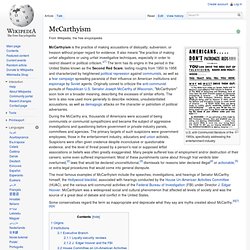
The primary targets of such suspicions were government employees, those in the entertainment industry, educators and union activists. Suspicions were often given credence despite inconclusive or questionable evidence, and the level of threat posed by a person's real or supposed leftist associations or beliefs was often greatly exaggerated. Many people suffered loss of employment and/or destruction of their careers; some even suffered imprisonment. Some conservatives regard the term as inappropriate and deprecate what they say are myths created about McCarthy.[6][7][8][9] Origins[edit] Institutions[edit] Executive Branch[edit]
Smith Act. The Alien Registration Act of 1940 (Smith Act), 76th United States Congress, 3d session, ch. 439, 54 Stat. 670, 18 U.S.C. § 2385 is a United States federal statute enacted June 29, 1940, that set criminal penalties for advocating the overthrow of the U.S. government and required all non-citizen adult residents to register with the government.
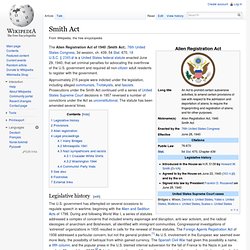
Approximately 215 people were indicted under the legislation, including alleged communists, Trotskyists, and fascists. Prosecutions under the Smith Act continued until a series of United States Supreme Court decisions in 1957 reversed a number of convictions under the Act as unconstitutional. The statute has been amended several times. Legislative history[edit] Dennis v. United States. First Red Scare. New York Evening Telegram November 1, 1919 Bolshevism and the threat of revolution became the general explanation for challenges to the social order, even such unrelated events as incidents of interracial violence.
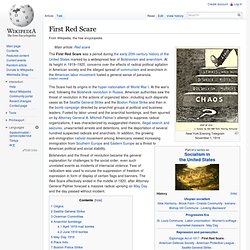
Fear of radicalism was used to excuse the suppression of freedom of expression in form of display of certain flags and banners. The Red Scare effectively ended in the middle of 1920, after Attorney General Palmer forecast a massive radical uprising on May Day and the day passed without incident. Origins[edit] Espionage Act of 1917. The Espionage Act of 1917 is a United States federal law passed on June 15, 1917, shortly after the U.S. entry into World War I.
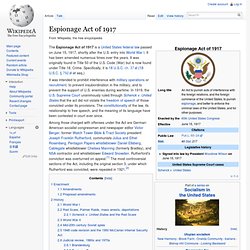
It has been amended numerous times over the years. It was originally found in Title 50 of the U.S. Code (War) but is now found under Title 18, Crime. Specifically, it is 18 U.S.C. ch. 37 (18 U.S.C. § 792 et seq.) It was intended to prohibit interference with military operations or recruitment, to prevent insubordination in the military, and to prevent the support of U.S. enemies during wartime. Among those charged with offenses under the Act are German-American socialist congressman and newspaper editor Victor Berger, former Watch Tower Bible & Tract Society president Joseph Franklin Rutherford, communists Julius and Ethel Rosenberg, Pentagon Papers whistleblower Daniel Ellsberg, Cablegate whistleblower Chelsea Manning (formerly Bradley), and NSA contractor and whistleblower Edward Snowden.
Enactment[edit] Congress moved slowly. It made it a crime: History[edit] Schenck v. United States. Schenck v.
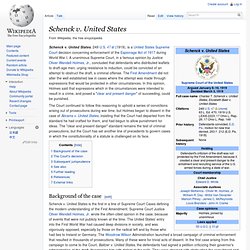
United States, 249 U.S. 47 (1919), is a United States Supreme Court decision concerning enforcement of the Espionage Act of 1917 during World War I. A unanimous Supreme Court, in a famous opinion by Justice Oliver Wendell Holmes, Jr., concluded that defendants who distributed leaflets to draft-age men, urging resistance to induction, could be convicted of an attempt to obstruct the draft, a criminal offense.
The First Amendment did not alter the well established law in cases where the attempt was made through expressions that would be protected in other circumstances. In this opinion, Holmes said that expressions which in the circumstances were intended to result in a crime, and posed a "clear and present danger" of succeeding, could be punished. The Court continued to follow this reasoning to uphold a series of convictions arising out of prosecutions during war time, but Holmes began to dissent in the case of Abrams v.
Palmer Raids. The Palmer Raids were attempts by the United States Department of Justice to arrest and deport radical leftists, especially anarchists, from the United States.

The raids and arrests occurred in November 1919 and January 1920 under the leadership of Attorney General A. Mitchell Palmer. Though more than 500 foreign citizens were deported, including a number of prominent leftist leaders, Palmer's efforts were largely frustrated by officials at the U.S. Department of Labor who had responsibility for deportations and who objected to Palmer's methods. The Palmer Raids occurred in the larger context of the Red Scare, the term given to fear of and reaction against political radicals in the U.S. in the years immediately following World War I. Background[edit] Preparations[edit] In June 1919, Attorney General Palmer told the House Appropriations Committee that all evidence promised that radicals would "on a certain day...rise up and destroy the government at one fell swoop.
" Aftermath[edit]